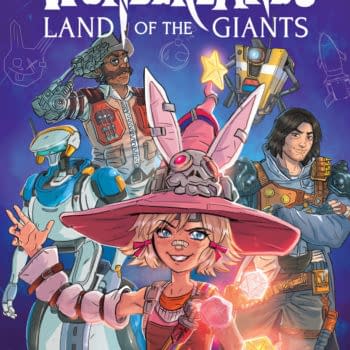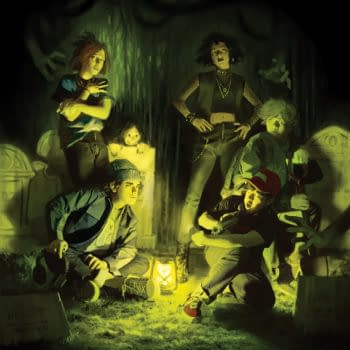Posted in: Comics, Recent Updates | Tagged: carl barks, Comics, Dry County, entertainment, indie Comics, Recoil Comics, rich tommaso, The Cavalier Mister Clay, top shelf
The Beautiful Genre Work Of Recoil Comics – Rich Tommaso Talks Shop
Mentioning Rich Tommaso's comics usually produces the same reactions in people, I've noticed. Firstly, they always know who I'm talking about, even if I preface it with a kind of "I won't judge you if you haven't heard of him" clause in case they haven't, and secondly they are pretty much in awe of him because of his professional skills, his compelling aesthetics, and his dedication to his craft. Rich has over 20 years experience making comics, having started pretty young, and a few years ago he decided that producing his own imprint, Recoil Comics, would be the best decision for him creatively. Since then he's continued to self-produce and publish an alarmingly attractive array of comics, but even more recently, the Recoil imprint has expanded to include the work of other noteworthy comics creators, usually with a slightly noir or retro aspect to the work.

Rich Tommaso joins us today to talk about his personal history in comics, the practicalities of self-publishing and production, and why moving away from realistic fiction into genre work has been a renaissance for him creatively.

Rich Tommaso: I always wanted to be a cartoonist. At age six I was very afraid that when I grew up I would decide to be a lawyer or something like that—but, by the age of sixteen, I was so ready to draw comics professionally. Good thing it took me another seven years to actually get published, though. Otherwise I'd have to live down some pretty lame funny-animal comics. Once high school was over, I decided to go to The Joe Kubert School—after calling up SVA and finding out that both Harvey Kurtzman and Art Spiegelman no longer taught there. The Kubert School was not accredited at the time (this was 1989), but I knew that it was a very good on-the-job type of training ground for aspiring cartoonists. I only lasted one year there—I figured I'd get the technical knowledge I needed and just run off and make my own comics.
Besides writing and drawing my own comics, I make money doing coloring work for Fantagraphics' Donald Duck and Uncle Scrooge archival collections. Before the coloring work, I only got lettering gigs. Entirely made up of me re-lettering a foreign graphic novel in English, aping the artist's lettering style. That work, thankfully, has completely dried up. I rarely do any illustration work apart from the occasional commission piece.
HMS: You've worked within some art and indie comics publishing, haven't you? What do you think the pros and cons of that world can be?
RT: The pros are that you can work with complete freedom, there's very little editing of your ideas going on in the indie world vs. working at say, Marvel or DC. The con is that you're always going to be dirt poor working on that side of the fence. My comics took forever to complete, having to juggle a full-time job at a pizzeria. Coloring Carl Barks' comics is a better day job.

RT: Well, the psychological part was the biggest hurdle to get over. I had to overcome the recurring thought of : "after 20 years in the business, am I really going to work myself backwards and self-publish mini-comics again?" But I felt that I had to do something… I wasn't getting any attention from the indie publishers I'd previously worked for, meanwhile I'd been producing all of these comic pages that were just sitting around in my flat files, collecting dust. I ended up really enjoying the whole throwback experience and it was liberating to have full control over the whole process. It was also instantly rewarding to be able to wrap up an issue of something and see the printed product, just one day later.
The most encouraging thing was having the support of so many great retailers behind me. The hard part was working on six different comics every week. I had to get out of the habit of taking my sweet little time on everything. But it ended up being an incredible kick-in-the-butt on that particular level—I had finally pushed my lazy ass to work on my comics 6 days a week—every week—consistently. The only other times in my life that I'd worked so diligently was when I produced both The Horror Of Collier County and Satchel Paige books—in those cases I was being paid well.
HMS: I think in recent years I've seen a real broadening out in the genres and types of comics you've been working on into distinctive categories and lines. You've also been able to control the materials and dimensions used to print these comics. Can you tell us about the different series, how they are distinctive from each other, and a little bit about your printing choices?

Now, the neighborhood Instant Copy shop has come a long way since the last time I made mini comics. The stuff they're able to achieve—especially when it comes to accurately reproducing color—was a very nice surprise to me when I got back into self-publishing. Years ago, I wouldn't have even bothered with color, because of bad reproduction. But I go to this great place here in Decatur called Toco Instant Printing and they do an excellent job for me every time. The sizes I went with were either 5 ½ X 8 ½" OR 7 ¼ X 11". The reason for these two different choices was based on the sizes of the original artwork. The comic pages I'd drawn with thick brushes and at a 10 X 15" or larger size, didn't look right shrunk down to the standard 5 ½ X 8 ½" mini comics size. There was something odd and super amateurish about looking at clean, brush-inked art in that mini format. Maybe the gross reduction made the art "too clean". Whereas, the comics that I was originally drawing at 7 X 11" with small pens and crowquill nibs reduced just fine.

RT: I try to keep to local shows—East Coast ones. Either HeroesCon, FLUKE or SPX. Sharing rooms with about seven of my friends always helps. All I can say is, you're going to reach more people if you attend shows. A few folks will know of my comics from my online presence, but most are coming into contact with my Recoil work for the first time when I'm at a show. It's still the best way to reach a select audience and sell a lot of books at once. When my comics were all online, my friends who knew about them always said they just skimmed the stories and were looking forward to actually reading them once they were in print form. Even as far as physical comic book sales go, I personally sell very little of my comics stock through online services.
HMS: What are some things you've been working on recently or are working on right now?
RT: Right now I'm just doing a lot of writing and plotting for future comics. Next month, Recoil is continuing to publish other authors' work with an anthology comic called Egg. It's the fourth issue of short crime stories written by Eric Skillman (Liar's Kiss, Top Shelf) and will feature artwork by Rachel Freire, Andrew Maclean, Maxim Simic, Matt Weigle and FATALE and CRIMINAL artist, Sean Phillips.

RT: I don't know how it works with other cartoonists, but I personally sell as much original artwork as I can to support myself. If it weren't for that, I'd be suffering from time to time, financially. Right now, I'm selling some large pieces (13 X 20" and 16 X 24" in size) from yet another work-in-progress project that looks like a lost EC comic book from the fifties. It's a 32-page comic tentatively titled, Death Sentence, a title I came up with back in 2010, when I first started the project. I've only got a cover and six pages of the project completed since then, so that'll give you an idea when that book will ever see the light of day! I've also got a few pages from the next Sam Hill book, The Mysterious Case, up for sale as well.
HMS: What are your favorite ideas or concepts as a creator to present in your comics?
RT: That's a tough one, it changes all the time. I spend more time making comic books than actually thinking about them. The themes, the other layers of the story, usually come to me out of the blue—while I'm already in the middle of producing the physical comic pages. Right now I'm interested in making my concepts more subversive. But at the same time trying to create work that is more entertaining—I want my new work to be fun, like watching a Michael Mann crime movie. On one level, his movies are just a fun ride, but on the other, the characters have definition, they have a back tory that makes them believable and real-to-life.
I also like having female leads for a lot of my stories. It's interesting to replace the typical male lead you'd find in a heist, mafia, murder mystery or prison scenario with a tough, complicated, yet flawed female lead. I love writing about people who're trying their best to get out from under—to land a good paying gig, to find a comfortable place to live, keep a stable relationship going. A person who tries to curb their unhealthy habits or obsessions—but just gets crushed by the world time and time again. I'm obsessed with a particular Ken Loach/Mike Leigh archetype that those two filmmakers seem to come back to often in their work: the man or woman who's trying to get their whole life in order as it's rapidly slipping through their fingers.

RT: Whether it's reality-based or fantasy, I like drawing familiar, broken-down, fully-realized characters. Blue-collar types. Putting Charles Bukowski in outer space would be an interesting prospect to me. I love cities and always try to draw a place that I know well. I can't always do that, if something has to be in 1940s Los Angeles, I have to read up as much as possible about that time and place and then spend days Googling for old photos like a mad man. I do prefer to be acquainted with a place in order to make comics about it. That really hasn't changed for me over the years—drawing people and places that are familiar to me.
I normally draw everything with extra small, small, medium and brush size Faber Castell pens. In the past, I was all about using sable brushes, but that was another long-time thing I never felt comfortable with. In the past, I drew really large pages, 11 X 17" to 19 X 27". Right now, everything I draw for Recoil Comics is drawn at 7 X 11". Makes it easier for a guy who draws six comics at once.
HMS: Are you going to be at any shows in 2015? How can people find out more about your work?
RT: I will be at HeroesCon and FLUKE this year. I should be at SPX as well.
The best place to go is recoilcomics.bigcartel.com for all current comics and original artwork. News items will generally go up on my twitter @RichTommaso.















